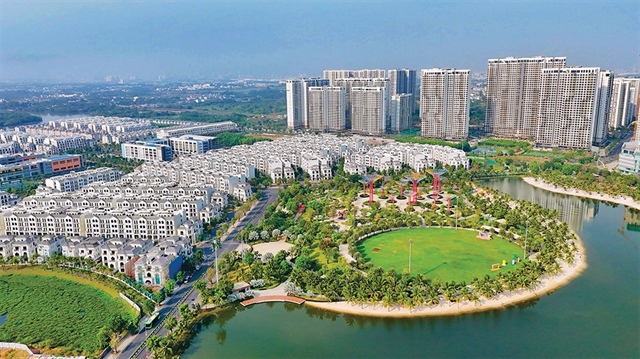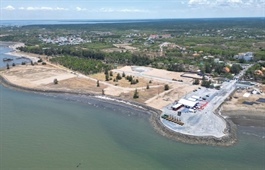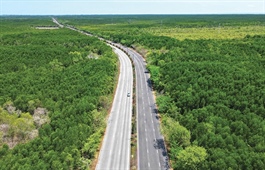Transparency the goal for real estate profit tax plan
Transparency the goal for real estate profit tax plan
The plan of charging a 20 per cent tax on the difference between the purchase price and the sale price of real estate is causing some controversy because it is difficult to determine the cost. However, some people believe it will ensure fairness and transparency.
In a report on the amended Law on Personal Income Tax sent to the National Assembly in early May, the Ministry of Finance (MoF) raised two methods for tax on real estate transactions: 20 per cent of taxable income (equalling the selling price minus the total costs related to the transferred real estate), or a 2 per cent tax rate on the total transfer price.

Transparency the goal for real estate profit tax plan, Photo: Le Toan |
Each method applied will depend on the database related to real estate transfers. In which, the case of 20 per cent tax on the profit of real estate will be used when the database can accurately determine the purchase price and related costs.
In the second case, if the purchase price and related costs of the real estate transfer cannot be calculated, imposing 2 per cent tax on the total transfer price of the individual’s real estate will be applied.
Agreeing with the MoF to raising tax for state budget revenue, Nguyen Van Dinh, chairman of Vietnam Association of Real Estate Brokers, commented that determining the input costs of a real estate transaction is complicated, especially for houses that were purchased decades ago, with expenses such as real estate brokerage, renovation costs, repair costs, and interest.
“If these costs cannot be calculated, sellers will lose the difference between selling and purchasing prices, which is not accurately their profit,” he said. “Moreover, determining the value of a house is not easy if it has not been on the market for a long time.”
Dinh said that tax policy should create motivation for market development instead of restricting transactions and liquidity, being fear from both buyers and sellers.
Nguyen Ngoc Tinh, vice president of the Ho Chi Minh City Tax Consultants and Agents Association, said that these two options have been discussed many times but the 2 per cent option has been chosen. In the case of imposing 20 per cent, it is difficult to collect enough invoices of costs like travel expenses, notarisation costs, and brokerage and legal fees. These costs will not be updated to the database and are difficult to prove.
“The biggest problem is how to determine valid expenses for individuals. At this time, when the database is not connected, imposing a 2 per cent tax on the total value of real estate is more reasonable. This option is convenient, fast, and determines tax obligations at the full tax rate. To avoid declaring incorrect purchase and sale prices, we need regulations on transactions on platforms and implement real estate identification to know the transaction history,” Tinh suggested.
Lawyer Hoang Van Ha from ARC Hanoi law firm said that the imposition of a 20 per cent tax on net profit from real estate transactions raises issues of tax overlap for both businesses and individuals.
Under the Law on Corporate Income Tax, businesses are subject to a common corporate income tax rate of 20 per cent on total taxable income, including income from production, business activities and real estate transfers, after deducting valid expenses.
“Applying an additional 20 per cent tax rate to profits from real estate transactions will create another tax layer, overlapping the existing corporate income tax. Without a clear offset or exemption mechanism, businesses may be taxed twice on the same income,” Ha said. “This increases input costs, seriously affects business strategy, long-term investment, and reduces the market’s ability to reinvest.”
However, lawyer Tran Minh Cuong from the Ho Chi Minh City Bar Association said that the 20 per cent tax rate on taxable income is “fair” for taxpayers.
“It is consistent with international practice and with corporate income tax, encouraging transparency in real estate transactions, including the purchase price and related costs. However, at present, it will take a lot of time and effort to determine the purchase price and costs,” he said.
In the long term, he suggested for a 20 per cent tax rate on profits. However, in the short term, if the data is not synchronised and the method of determining the cost price and expenses is still inadequate, people can choose one of the two options as proposed by the MoF. This will both encourage people to store more complete and transparent transaction records and avoid congestion in transfer transactions when the data system is still not strong enough.
The MoF affirmed that the tax authority’s database can check the transaction history of the land plot and look up the transaction history of the taxpayer since 2018. However, the transfer price on the contract is still not correct with the actual transaction price on the market. Furthermore, some transferred real estate transferred have undergone no transactions for years, or were inherited or donated, so the value cannot be determined.
|
Duong Tong, deputy head, Galaxy Group Both proposed personal income tax methods of 20 and 2 per cent on property transfers have their own merits, depending on the market context and the government’s data management capacity. The 20 per cent tax on capital gain, calculated as the difference between the purchase and selling price, would be suitable once tax authorities have a transparent and accurate database of property purchase prices and related costs. This method encourages transparency in transaction values and can enhance state revenue, but it requires a well-functioning data infrastructure and strong enforcement capabilities. On the other hand, the flat 2 per cent tax on the total transaction value is much simpler and easier to implement. It aligns with the current state of the real estate market, where comprehensive transaction data is still lacking. However, this method may not accurately reflect actual income from sales, and in some cases, it may unfairly burden those with minimal or no real profit. Given that Vietnam’s property market is in a slow recovery phase, the 2 per cent tax seems more pragmatic for now, as it avoids placing additional financial pressure on buyers and businesses. While the 20 per cent capital gains tax may be theoretically fairer, it risks increasing transaction costs and could dampen investor interest. Challenges associated with the 20 per cent approach include difficulties for enterprises in accurately determining acquisition costs and related expenses, due to inconsistent data across different agencies. This could lead to higher compliance costs. Meanwhile, end-users and small-scale investors could end up bearing a disproportionate tax burden, potentially deterring participation in the market. The solution lies in building a transparent, interconnected real estate data system that integrates information across relevant agencies. A gradual implementation roadmap should also be considered, along with preferential policies for social housing transactions and first-time homebuyers. These steps would help avoid market shocks and support long-term sustainable development. Giang Huynh, director of Research Savills Ho Chi Minh City Among the two tax proposals under review by Vietnam’s Ministry of Finance, I believe the flat 2 per cent personal income tax on the total real estate transfer value remains the more suitable solution under current market conditions. The alternative, a 20 per cent tax on capital gains, can only be effectively implemented if Vietnam has a robust, up-to-date real estate valuation system that accurately reflects market prices. This would require a comprehensive, continuously updated national database capturing actual purchase prices, investment costs, and related transaction data. Moreover, it demands a transparent, consistent mechanism for data collection, verification, and processing, backed by broad public consensus. Calculating profit margins can easily lead to disputes, as each party may interpret cost structures differently. Currently, however, Vietnam’s real estate data infrastructure remains fragmented. Property transfer prices are largely based on self-declared figures in purchase contracts, while actual transaction values are often higher. This gap could make profit-based taxation difficult to enforce and may lead to disputes or even legal challenges. Until Vietnam’s data systems and legal framework can ensure transparency, accuracy, and public trust, maintaining the flat 2 per cent tax on total transfer value is a safer and more feasible approach. Implementing profit-based tax policies prematurely could introduce several risks: delays in tax declarations due to disagreement between buyers and sellers over taxable amounts, higher transaction risks, and heavier administrative burdens. Individuals would be expected to store and provide valid documentation for all property-related expenses, including purchase invoices, renovation costs, and more. Therefore, before moving forward with profit-based taxation, we must first establish a comprehensive data ecosystem: a verified, real-time market price database, streamlined, digitalised transaction tracking, and seamless integration of data from tax authorities, notary offices, banks, and land registries. These steps would increase transparency and gradually normalise price declarations. A clearly defined implementation of a roadmap is also essential. In the initial phase, the policy could be piloted in selected areas where reliable and accurate data already exists. Only once these pilots prove successful and gain widespread public acceptance should the policy be expanded to other regions. Dinh Minh Tuan, southern director Batdongsan.com.vn While the 20 per cent approach appears logical and aims to reflect market realities and maximise tax revenue, its implementation could pose significant challenges. For property investors, the matter is simple: any increase in transaction-related costs, be it the 20 per cent tax or a 1-3 per cent brokerage fee, will be passed directly onto the buyer. As a result, the sale price will rise accordingly, contributing to a further increase in housing prices. Even modest under-declarations at notarisation could lead to substantial tax losses for the state. For genuine homebuyers, the outcome could be worse. Rising prices mean reduced accessibility to housing, especially for first-time buyers or low-income earners. Higher tax burdens may also discourage transactions, deepening housing inaccessibility and dampening market liquidity. From a tax administration perspective, determining the legitimate cost basis for each property transaction is a complex undertaking, particularly for homes purchased decades ago. Costs could include original purchase price, brokerage fees, renovations, repairs, interest payments on loans, and more. If these cannot be fully verified, sellers may face a 20 per cent tax on nominal gains, even if actual profits are minimal. In my view, introducing this 20 per cent capital gains tax now could generate uncertainty and reluctance among both buyers and sellers. Vietnam remains one of the countries with the lowest property-related tax burdens globally. Taxes on property profits have yet to be widely enforced, and total transaction-related costs generally remain under 10 per cent. Meanwhile, property prices continue to trend upward. Implementing such a tax policy without a robust and transparent system for cost verification and market valuation could inadvertently shift the burden onto those least able to bear it: genuine homeseekers. Vo Hong Thang, investment director DKRA Group If legitimate documentation can clearly substantiate the purchase price and incurred costs, then applying a 20 per cent tax on actual profits could benefit individual sellers in the property market. Moreover, in adverse market conditions where the selling price is equal to or lower than the total costs, the taxpayer could potentially qualify for tax exemptions or reductions, offering a more equitable outcome. Notably, this profit-based taxation approach is not entirely new. Vietnam’s 2007 Personal Income Tax Law allowed for two calculation methods. However, subsequent revisions unified the approach under the 2 per cent method. Reintroducing the profit-based formula may face challenges, particularly around accurate price disclosure and verification. That said, market transparency has improved in recent years. Authorities are now actively investigating under-reported transactions, with cases referred for criminal prosecution to deter tax evasion. As Vietnam continues to refine its national real estate database, compliance and enforcement are expected to further improve. Nonetheless, key implementation challenges remain, particularly in determining the original cost basis for properties acquired via inheritance or gifts, and substantiating related costs such as construction, renovation, or mortgage interest payments. Unlike businesses, where such expenses can be clearly documented and deducted, individuals often rely heavily on financial leverage and may face difficulties substantiating these figures. Therefore, a clear framework is essential. For example, mortgage interest should be considered deductible, land costs could reference official land price tables (to be applied from 2026), valuations from licensed appraisal firms, or construction costs based on annual guidelines issued by the Ministry of Construction. |
- 10:46 13/05/2025




























